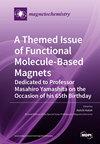Preparation of Magnetic Molecularly Imprinted Polymer for Methylene Blue Capture
IF 2.5
4区 化学
Q2 CHEMISTRY, INORGANIC & NUCLEAR
引用次数: 1
Abstract
Hybrid magnetic molecularly imprinted polymers (MMIPs) have the advantages of the technology of molecularly imprinted material and magnetic nanoparticles. The magnetic properties of MMIPs allow easy magnetic separation of various pollutants and analytes. A convenient and simple approach has been developed for the preparation of MMIPs based on polyamide (nylon-6) and magnetic nanoparticles. The polymer matrix was formed during the transition of nylon-6 from a dissolved state to a solid state in the presence of template molecules and Fe3O4 nanoparticles in the initial solution. Methylene blue (MB) was used as a model imprinted template molecule. The MMIPs exhibited a maximum adsorption amount of MB reached 110 µmol/g. The selectivity coefficients toward MB structural analogs were estimated to be 6.1 ± 0.6 and 2.1 ± 0.3 for 15 μM hydroxyethylphenazine and toluidine blue, which shows high MMIP selectivity. To prove the MMIPs’ specificity in MB recognition, magnetic nonimprinted polymers (MNIPs) were synthesized without the presence of a template molecule. MMIPs exhibited much higher specificity in comparison to MNIPs. To show the remarkable reusability of the MMIP sorbent, more than four MB absorption and release cycles were carried out, demonstrating almost the same extraction capacity step by step. We believe that the proposed molecular imprinting technology, shown in the MB magnetic separation example, will bring new advances in the area of MMIPs for various applications.用于亚甲基蓝捕获的磁性分子印迹聚合物的制备
杂化磁性分子印迹聚合物(MMIPs)具有分子印迹材料技术和磁性纳米颗粒技术的优点。磁性的MMIPs允许容易的各种污染物和分析物的磁分离。为制备基于聚酰胺(尼龙-6)和磁性纳米颗粒的MMIPs提供了一种方便、简单的方法。在初始溶液中存在模板分子和Fe3O4纳米颗粒的情况下,尼龙-6由溶解态向固态转变形成聚合物基质。亚甲基蓝(MB)作为模型印迹模板分子。MMIPs对MB的最大吸附量可达110µmol/g。15 μM羟乙基吩那嗪和甲苯胺蓝对MB结构类似物的选择性系数分别为6.1±0.6和2.1±0.3,具有较高的选择性。为了证明磁性非印迹聚合物在MB识别中的特异性,我们在没有模板分子存在的情况下合成了磁性非印迹聚合物(MNIPs)。与MNIPs相比,MMIPs表现出更高的特异性。为了证明MMIP吸附剂具有显著的可重复使用性,进行了4次以上的MB吸收和释放循环,每一步都显示出几乎相同的萃取能力。我们相信,所提出的分子印迹技术,如MB磁分离实例所示,将为MMIPs领域的各种应用带来新的进展。
本文章由计算机程序翻译,如有差异,请以英文原文为准。
求助全文
约1分钟内获得全文
求助全文
来源期刊

Magnetochemistry
Chemistry-Chemistry (miscellaneous)
CiteScore
3.90
自引率
11.10%
发文量
145
审稿时长
11 weeks
期刊介绍:
Magnetochemistry (ISSN 2312-7481) is a unique international, scientific open access journal on molecular magnetism, the relationship between chemical structure and magnetism and magnetic materials. Magnetochemistry publishes research articles, short communications and reviews. Our aim is to encourage scientists to publish their experimental and theoretical results in as much detail as possible. Therefore, there is no restriction on the length of the papers. The full experimental details must be provided so that the results can be reproduced.
 求助内容:
求助内容: 应助结果提醒方式:
应助结果提醒方式:


